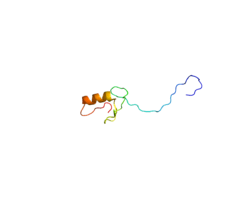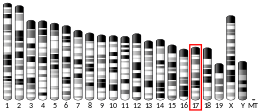TRIM31
Tripartite motif-containing protein 31 is a protein that in humans is encoded by the TRIM31 gene.[5][6]
The protein encoded by this gene is a member of the tripartite motif (TRIM) family. The TRIM motif includes three zinc-binding domains, a RING, a B-box type 1 and a B-box type 2, and a coiled-coil region. The protein localizes to both the cytoplasm and the nucleus. Its function has not been identified.[6]
Interactions
TRIM31 has been shown to interact with TRIM23.[5]
gollark: I simply type faster.
gollark: I find it okay, but I may just be inured to the horrors.
gollark: I don't have very high uptime requirements.
gollark: Except when postgres broke once because I have it under ignorepkg but its dependencies updated anyway.
gollark: pacman is perfectly generally okay ish.
References
- ENSG00000137397, ENSG00000233573, ENSG00000224168, ENSG00000225130, ENSG00000226402, ENSG00000224542, ENSG00000204616 GRCh38: Ensembl release 89: ENSG00000223531, ENSG00000137397, ENSG00000233573, ENSG00000224168, ENSG00000225130, ENSG00000226402, ENSG00000224542, ENSG00000204616 - Ensembl, May 2017
- GRCm38: Ensembl release 89: ENSMUSG00000058063 - Ensembl, May 2017
- "Human PubMed Reference:". National Center for Biotechnology Information, U.S. National Library of Medicine.
- "Mouse PubMed Reference:". National Center for Biotechnology Information, U.S. National Library of Medicine.
- Reymond A, Meroni G, Fantozzi A, Merla G, Cairo S, Luzi L, Riganelli D, Zanaria E, Messali S, Cainarca S, Guffanti A, Minucci S, Pelicci PG, Ballabio A (May 2001). "The tripartite motif family identifies cell compartments". EMBO J. 20 (9): 2140–51. doi:10.1093/emboj/20.9.2140. PMC 125245. PMID 11331580.
- "Entrez Gene: TRIM31 tripartite motif-containing 31".
Further reading
- Maruyama K, Sugano S (1994). "Oligo-capping: a simple method to replace the cap structure of eukaryotic mRNAs with oligoribonucleotides". Gene. 138 (1–2): 171–4. doi:10.1016/0378-1119(94)90802-8. PMID 8125298.
- el Kahloun A, Chauvel B, Mauvieux V, et al. (1993). "Localization of seven new genes around the HLA-A locus". Hum. Mol. Genet. 2 (1): 55–60. doi:10.1093/hmg/2.1.55. PMID 8490624.
- Suzuki Y, Yoshitomo-Nakagawa K, Maruyama K, et al. (1997). "Construction and characterization of a full length-enriched and a 5'-end-enriched cDNA library". Gene. 200 (1–2): 149–56. doi:10.1016/S0378-1119(97)00411-3. PMID 9373149.
- Strausberg RL, Feingold EA, Grouse LH, et al. (2003). "Generation and initial analysis of more than 15,000 full-length human and mouse cDNA sequences". Proc. Natl. Acad. Sci. U.S.A. 99 (26): 16899–903. doi:10.1073/pnas.242603899. PMC 139241. PMID 12477932.
- Mungall AJ, Palmer SA, Sims SK, et al. (2003). "The DNA sequence and analysis of human chromosome 6". Nature. 425 (6960): 805–11. doi:10.1038/nature02055. PMID 14574404.
- Hillman RT, Green RE, Brenner SE (2005). "An unappreciated role for RNA surveillance". Genome Biol. 5 (2): R8. doi:10.1186/gb-2004-5-2-r8. PMC 395752. PMID 14759258.
- Gerhard DS, Wagner L, Feingold EA, et al. (2004). "The status, quality, and expansion of the NIH full-length cDNA project: the Mammalian Gene Collection (MGC)". Genome Res. 14 (10B): 2121–7. doi:10.1101/gr.2596504. PMC 528928. PMID 15489334.
- Rual JF, Venkatesan K, Hao T, et al. (2005). "Towards a proteome-scale map of the human protein-protein interaction network". Nature. 437 (7062): 1173–8. doi:10.1038/nature04209. PMID 16189514.
- Oh JH, Yang JO, Hahn Y, et al. (2006). "Transcriptome analysis of human gastric cancer". Mamm. Genome. 16 (12): 942–54. doi:10.1007/s00335-005-0075-2. PMID 16341674.
- Shiina T, Ota M, Shimizu S, et al. (2006). "Rapid evolution of major histocompatibility complex class I genes in primates generates new disease alleles in humans via hitchhiking diversity". Genetics. 173 (3): 1555–70. doi:10.1534/genetics.106.057034. PMC 1526686. PMID 16702430.
This article is issued from Wikipedia. The text is licensed under Creative Commons - Attribution - Sharealike. Additional terms may apply for the media files.







